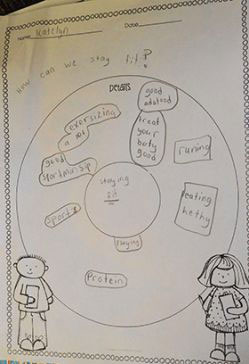When it comes to digging deeper into reading, writing, vocabulary, science or math; giving details about the beginning, middle and end of a story or event; or explaining the cause and effect of an action, Dutton Elementary students are learning: there’s a Thinking Map for that.
Using maps with names like Circle, Bubble, Double-Bubble, Tree and Flow, students are making their thoughts pop, grow and glide in organized fashion. It’s an approach that’s really about brain development, and it’s helping students categorize what’s in their head by writing, doodling and thinking, thinking, thinking.

“You go deeper into the story to describe what the main idea is,” said second-grader Steven Pekrul about using a Tree Map in reading. He demonstrated by making a list of ways to stay fit, jotting down “practice” and “try hard” on the map’s branches.
“Research shows the brain classifies information in eight different ways,” said Principal Shawn Veitch. Those include processes like classifying, seeing analogies and defining. “Over 75 percent of information we learn is done visually. Hence, the importance of teaching our kids to be visual thinkers… (with Thinking Maps) students have the tools to organize their thoughts.”
Kim Chausow, Thinking Maps trainer and Thornapple Kellogg Public Schools curriculum director, is training Dutton teachers to guide students, beginning in kindergarten, to organize their thoughts in a systemic way, which enhances problem solving and critical thinking skills, she said. The eight map styles go with the eight processes of thinking, which help students sort details, use descriptions and understand sequencing. Thornapple Kellogg has also implemented Thinking Maps.
“It’s about kids feeling empowered to use their thinking,” Chausow said.

A Map for Success
Second-grade teacher Renee O’Dowd is using maps in all content areas, even starting the day with her students surrounding their Circle Maps, focused on ways to stay fit and healthy.
O’Dowd, a 10-year Dutton teacher, said her students are learning at deeper levels because of the maps and naturally turning to them during class. “I really can’t lesson plan without them now. Kids are so familiar with them that there’s no time lost explaining. This has been such a valuable tool to get kids to engage, connect and think deeper. The kids are really tuned in.”
Chausow said Thinking Maps mesh well with Common Core standards, which require students to demonstrate deeper learning. “What it’s asking kids to do is think. We don’t know what jobs kids will have. We don’t know what they will be expected to do in the future. But we do know they are going to have to think think. Information is coming at us faster and faster, so we need kids to be able to think and process.”
Veitch said they also add another layer to the district’s Multi-Tiered Systems of Support, a school-wide support system in reading and behavior that also involves teaching a common language for students, teachers and staff to use school-wide.
In O’Dowd’s class, students said the like using the maps for different activities. “They help you describe!” said excited second-grader Elijah Pewee. And what’s the best describing word he’s used in mapping? “Discombobulated!” he said.
CONNECT





